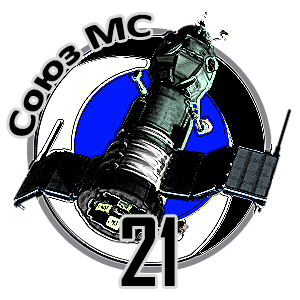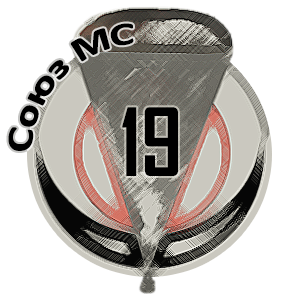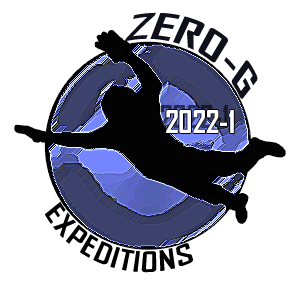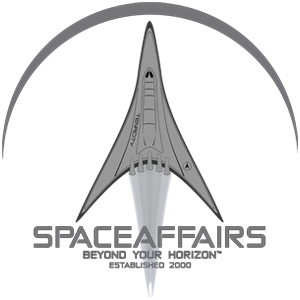
Centrifuge TfS-18
Sojus Descent Training
by Andreas P. Bergweiler (D) September 2003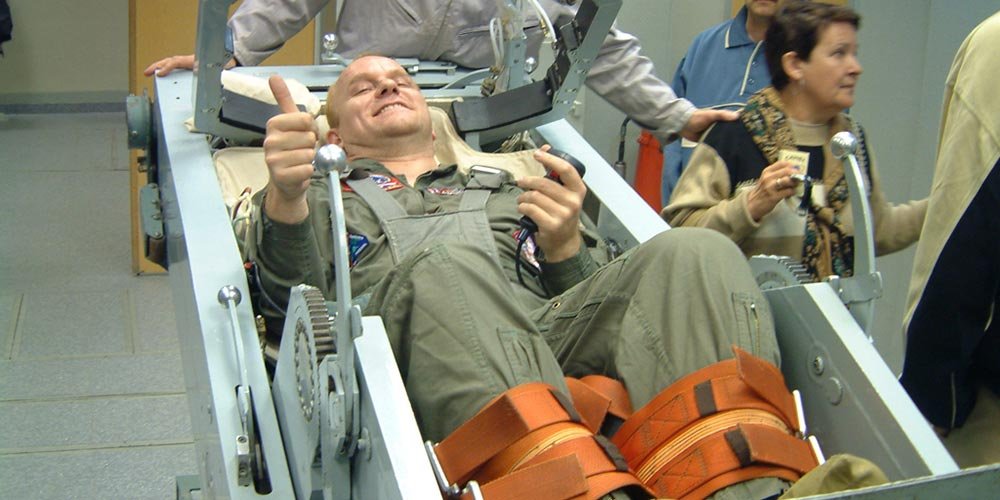
Centrifuge TfS-18 - Soyuz Descent Training - or: more than just driving in circles!
From the Captain’s LogOn my latest trip to Russia, I not only had the need to overcome 38 years of earth gravity. I also wanted to learn to feel the other extreme, which I had already sensed when I climbed the Ilyushin 76 to the parabola: acceleration forces, so-called G-forces, which put weight on you and make some movements almost impossible. So on the morning of 04.09.2003, I went to a popular complex in the GCTC where the huge centrifuge TFS-18 is located.
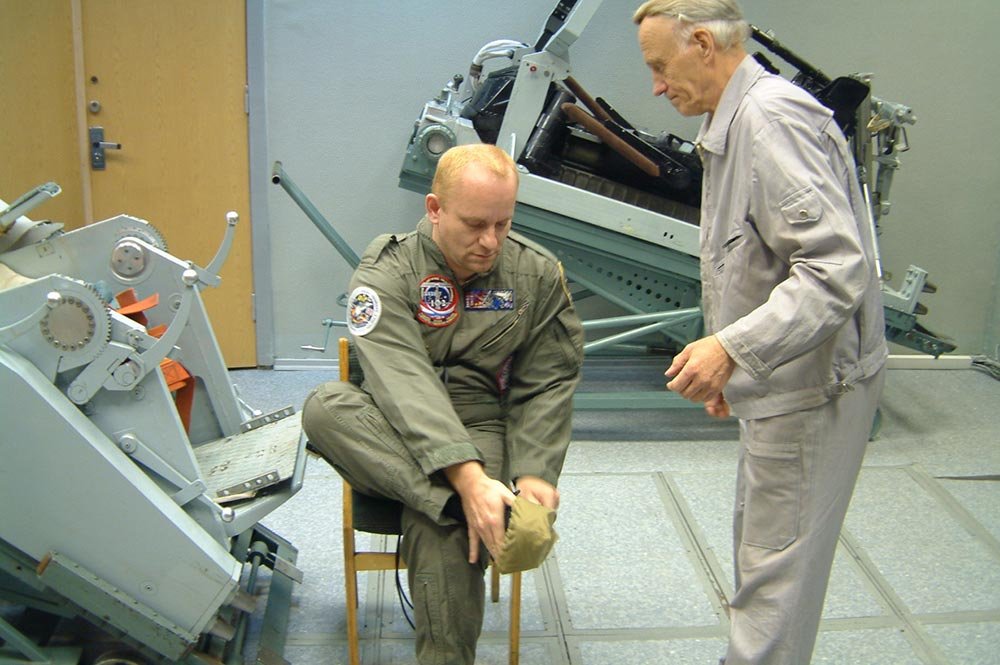 Just don't get dirty - TFS-18 - September 2003
Just don't get dirty - TFS-18 - September 2003The centrifuge was built by a Swedish specialist company and until recently was one of the largest in the world. In it, acceleration forces can be built up which are beyond 30 G! Imagine that: They weigh on the ground 80 KG (to remain again with our example of the parabolic flight). It is not possible to confront a human being with such a burden, but this is only a thought game. At a weight of 80 kilograms you would weigh 2,400 kilograms in the centrifuge at 30 G! (80kg x 30G = 2,400 kilograms). Almost two and a half tons! You can perhaps imagine that no human would survive this. But let's move on to the next step in the "How to feel like a Cosmonaut!
11.00 a.m.:
With, admittedly, somewhat "soft" knees I enter the anteroom of the centrifuge and am then led into a room where a doctor awaits me. She means "upper body free" in Russian, and I follow her tone. She puts electrodes on me, which will measure my heart activity, breathing, blood pressure and pulse during the ride with the centrifuge. She sprays alcohol onto my skin, which is known to be very cold. There are no big "expressions of sympathy" from her side, I notice again that I am here among professionals who know what they are doing. After 10 minutes the electrodes sit correctly, and I can get dressed still. In my mind, I am in the time when I saw the centrifuge live for the first time, during a short visit before my trip to the Water Survival Training in Sochi in September 2001. At that time I walked under the centrifuge with Michael Schultz, my companion, and was fascinated by the size of the hall and the centrifuge. At that time I would never have dared to dream of riding this centrifuge one day.
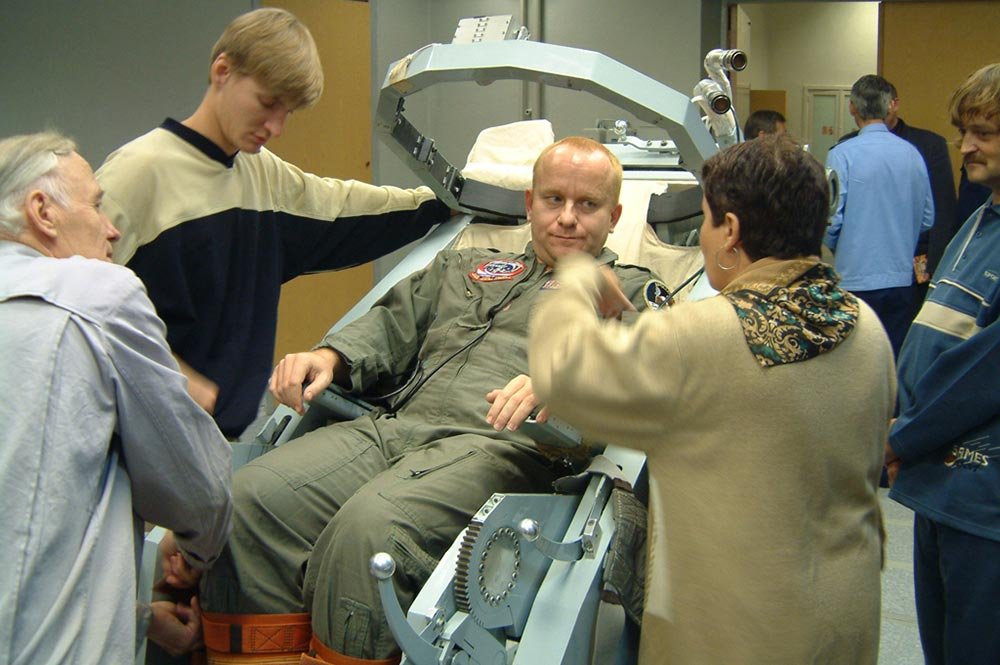 Inside the centrifuge chair - TFS-18 - September 2003
Inside the centrifuge chair - TFS-18 - September 2003Space travellers are tested here to see whether they can withstand the acceleration forces that can occur during launch and especially when re-entering the atmosphere with the Soyuz capsule. At the start the G-Force is approx. 3.2 G throughout 7 minutes, at re-entry between 3.2 and 4.5 G. The strength of these forces is only exceeded in exceptional situations. Only three times in the history of Russian space travel has it happened that the space travellers were exposed to higher loads, most recently in the history of the return flight of the ISS crew 6 with the brand new Soyuz-TMA spacecraft: Their return flight path was not optimal, and they crashed in a ballistic return flight path towards Earth. In the process, forces were built up which must have been above 9 - 10 G in some cases. For comparison: The American Space Shuttle has a maximum of 4 G during takeoff and landing. Of course, this has something to do with the design of the spaceships, the Space Shuttle is more like a glider, the Russian Soyuz capsule is a conical barrel, which is braked from 28,000 kilometres per hour to just under 600 kilometres per hour when it races through the atmosphere for 7 minutes in an ionising shell of gas.
If the return curve is optimal, temperatures of more than 1,800 degrees Celsius occur on the outer skin, the heat shield almost entirely burns off, and the cosmonauts on board the Soyuz can literally see their outer skin being welded off at the two windows of the spaceship! But, the past has definitely shown: a very safe, even if very exhausting return journey to Earth. But I think, such a mission cannot be compared to a trip to Tenerife or Mallorca, which you can book at any travel agency for little Euro.
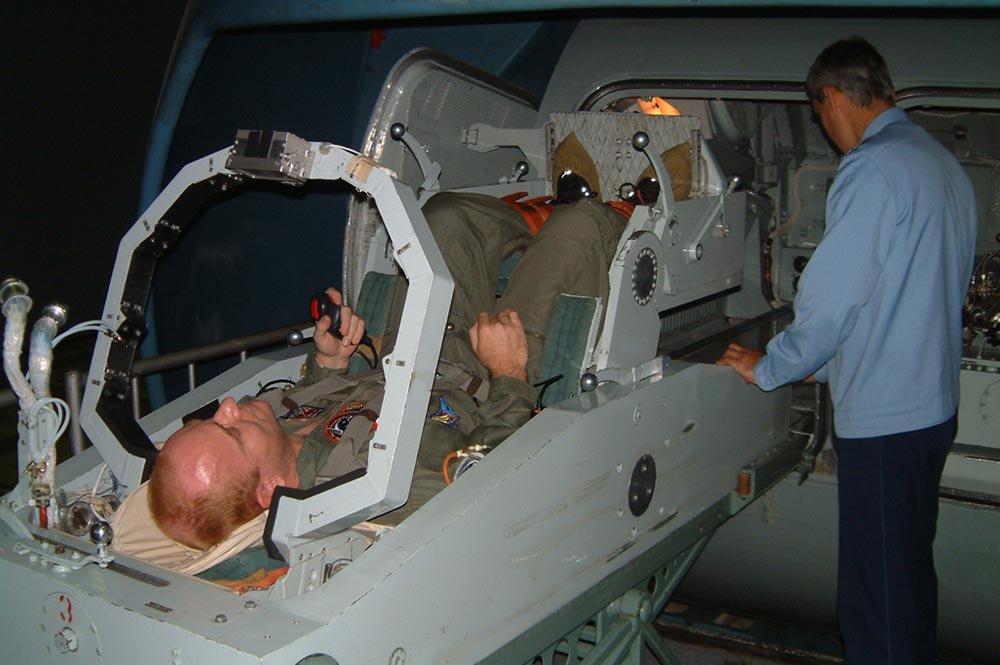 Tension before the journey - TFS-18 - September 2003
Tension before the journey - TFS-18 - September 2003Thoughts - before the journey
Back from the area "Excursion into technology" to the centrifuge: After I had the medical check over me, I am led by personnel to the centrifuge spring chair, which looks more like an electric chair. I feel as if my last hour has come and I am on my way to the execution of the sentence. Nonsense, Andreas - I pull myself together, this comparison is absolutely unnecessary. I sit down on a stool and put on foot protectors. Then I sit back in the seat, which resembles the sitting position in a Soyuz capsule. However, I have to note at this point that this seat is much more comfortable. The seat in a Soyuz resembles a "seat tub rather". But it's not uncomfortable once you've found the right sitting position. It is also the best sitting position to distribute the forces that occur during take-off and landing. They mainly affect the back and chest, a very stable yet flexible part of the human body. After I have taken the correct sitting position, my medical wiring is attached to the seat so that the doctors in the room above can immediately observe my heartbeat and my further well-being. I no longer feel excited and let things come to me. Two technicians and a doctor look after me and buckle me down so that I can hardly move. A sitting position that is too loose would result in many bruises, as well as one that is too firm. It is essential that I have nothing firm in my pockets of the overalls, which could cause me injuries while driving. And so I empty my pockets so that I can be really safe.
11.30 a.m.:
The seat is pushed on a chassis in the direction of the centrifuge hatch. From my sitting position, it looks more like the mouth of a monster waiting for a meal. My seat is brought to the right height and manoeuvred on a sledge into the centrifuge. I see some heads above me, also of Thomas Kraus, my companion who takes photos. Everyone smiles at me, I must actually look as if I am going on a journey from which I will not return.
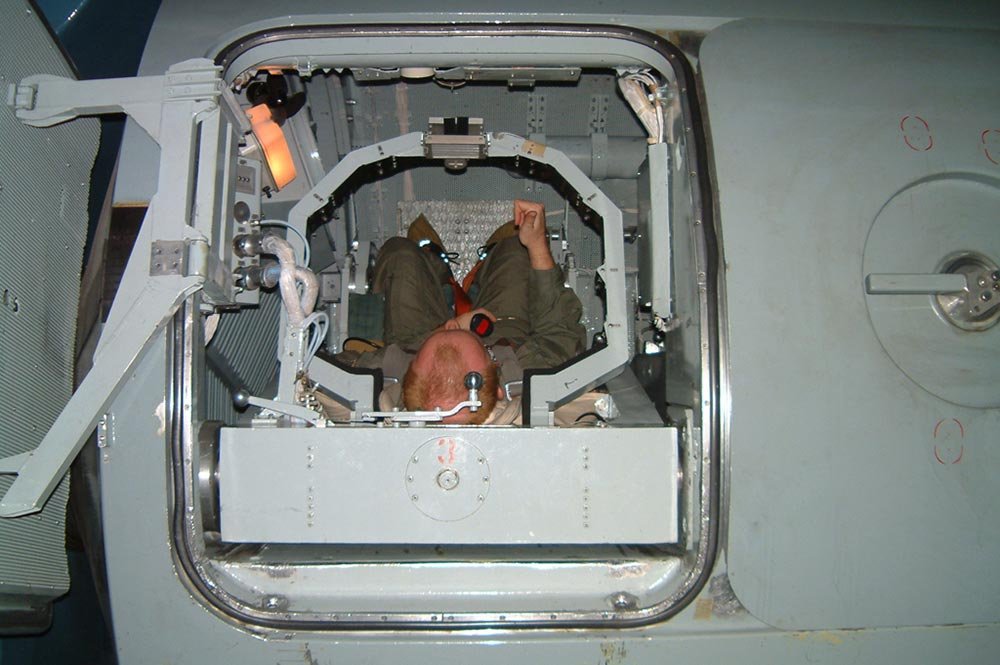 Let's go to space - TFS-18 - September 2003
Let's go to space - TFS-18 - September 2003I look around in the centrifuge. Two cosmonauts can be examined at the same time, to my left there is another hatch with a sledge, but it is empty. Furthermore, I notice a cross in front of my eyes at a distance of about 30 centimetres. Somehow I already feel as if I am going on a journey to the stars and notice the enormous effort that is necessary to send a person on such a trip. Over the last hundred years man has learned a lot: whether it is to fly with engine power (Wright Brothers, Kitty Hawk/USA 1903) or to be the first man in space (Juri Gagarin, April 12, 1961). The technique has become more sophisticated, the methods have partly become more pleasant, but the species has not changed. The safety precautions are enormous, and this also makes a crewed space flight so expensive, after all, one does not only want to send a human or even several upwards but also that they come down safely again!
After another 5 minutes, the hatch behind me is closed, and I am alone. Silence becomes noticeable, and I hear an electric humming. The gangway is driven back, and the movie "Contact" with Jodie Foster comes to my mind when she goes on the journey to the stars as astronomer Elenor Arroway, but quite far away from Earth to establish the first contact with an extraterrestrial culture that leads her to the edge of her being. Like the images, I think! The loudspeaker wakes up: "Hello Andreas, this is Zorja" says my German translator. "We are all here in the control room and can see you on the monitor. You look like a hero!" Good that the TV picture is only black and white, I think because otherwise, you could see that I get a slightly red face colour. I say "Hello to everyone" embarrassed and grin into the eye of the camera. Another movie comes to mind: 2001- A Space Odyssey. The eye of the computer HAL 9000. That's exactly what this camera eye looks like, but within seconds I gave my mind the opportunity to merely forget this camera. I feel alone and hear a countdown in my head.
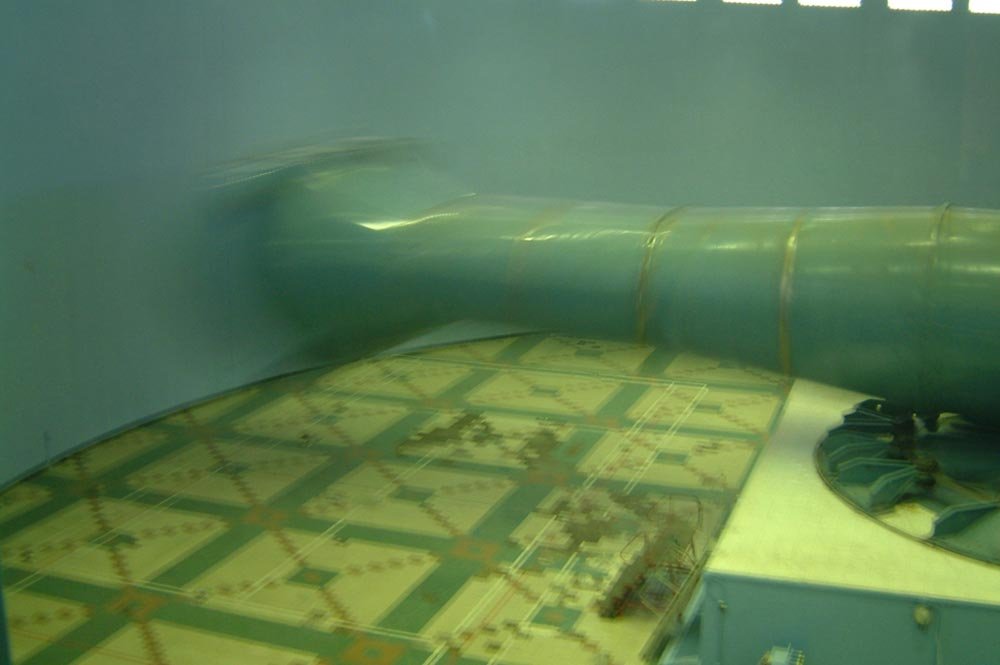 The centrifuge in motion - TFS-18 - September 2003
The centrifuge in motion - TFS-18 - September 2003Spinning around!
Something's starting to move. The centrifuge dome is transferred to another position so that I really don't lie down anymore, but actually, sit. Then, after a short time, it starts to move. At first slowly. I can't estimate yet how fast it moves, all of a sudden I hear the voice "1G" from the loudspeaker. Hm, - I think, you don't notice that at all. I hear "2G" from the loudspeaker. Hm, I think again, yesterday when I climbed during the parabola I felt heavier. I notice how the centrifuge rotates, try to guess how fast. But I don't succeed. Zorya says "3G" over the loudspeaker, and I feel the heaviness seizing me. The first thing you notice is breathing. Breathing becomes more difficult, and you have to exert yourself more. "Are you all right? a voice in the loudspeaker asks me. "Are you feeling alright?" "Yes. I´m feeling excellent" I say back, and that's not even a lie. I roll my eyes and move my head a little to the left and right to get a little feeling for the changing forces. I notice how my intraocular pressure increases. "Look at the cross," says the doctor whose voice I recognise. I concentrate and fix with my eyes the cross, which is 30 centimetres in front of my eyes. My eyes remain calm and do not begin to tremble.
I notice this immediately, as I have heard from books of astronauts that the movement of the eyes is controlled to control later during the space flight that one has the correct display instruments and the right buttons in the eye.
If the eye trembles, double images occur, and thus misjudgements are made. People who have a problem with this are not suitable for a space flight because they represent a safety risk. I hear the voice say "4G". So I think. So I'm on my way in a centrifuge, strapped to a spring chair. A small "Space Odyssey". I haven't left Earth yet, but I think it could happen right now. I feel good, and the ride with the centrifuge continues. The weight on my chest is getting stronger and stronger, and I start to breathe more through my stomach (abdominal breathing) because the muscles of the breast now have to expend more strength.
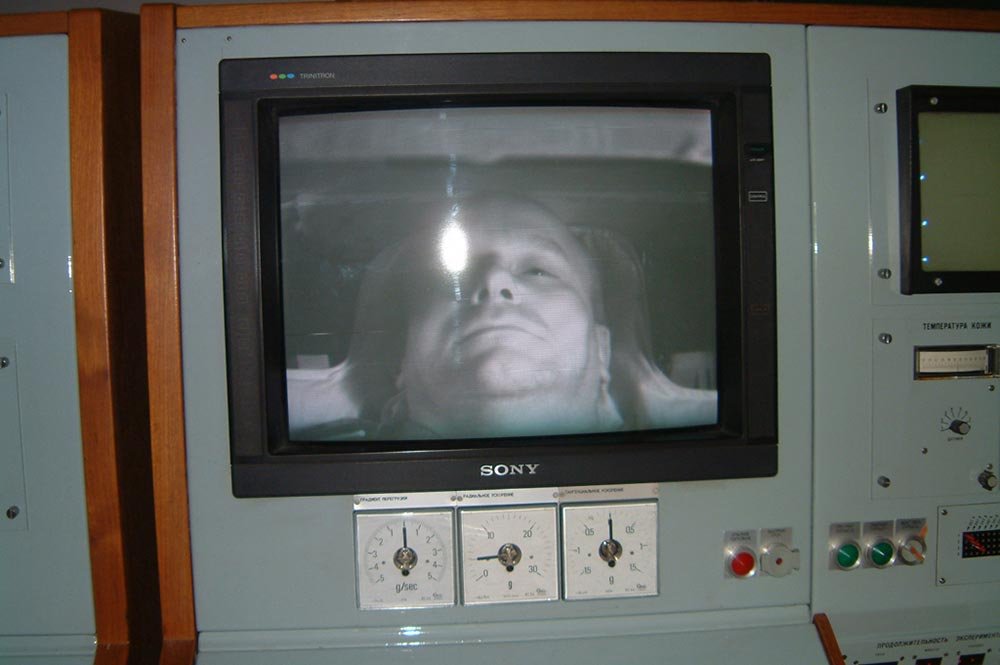 Feeling the acceleration - TFS-18 - September 2003
Feeling the acceleration - TFS-18 - September 2003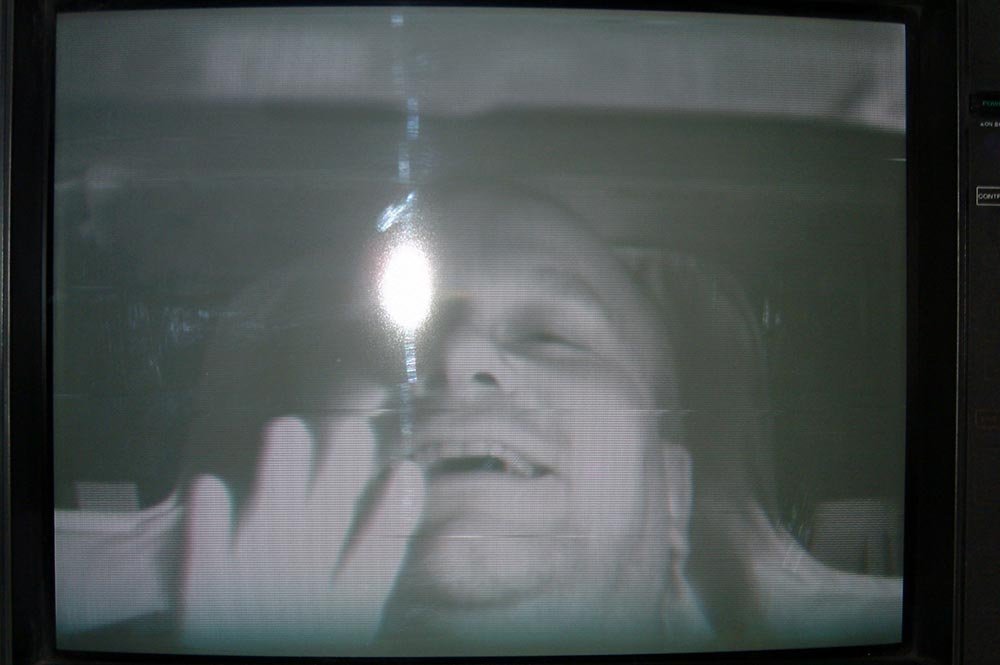 Trying to look good - TFS-18 - September 2003
Trying to look good - TFS-18 - September 2003"Try to wave into the camera" I hear Zorya say. And I try. My God, I'm getting heavier and heavier, and now I'm supposed to wave into the camera? I hold a joystick in my left hand. I hold a button down with my fingers, this button gives me the security of being able to interrupt the rotation of the centrifuge at any time if it gets too much for me. Letting go is easier under these G-forces than pressing, so you only have to let go of the joystick, and the ride would stop.
I continue to rotate, the force continues to increase. I feel good and manage to raise my right hand so high that the camera captures it. I wave into the camera and probably grin very stupidly, but in this case, I don't care. You probably know movies where heroes are confronted with G-forces. Everything disappears, and you don't recognise yourself in such a case. The skin on the cheeks is pulled back, they feel as if someone is sticking tape strips to your cheeks and forehead, and then pulling them back hard. The tongue hangs somewhere deep in the back of your throat. After 7 minutes the ride ends. The forces slowly go down again, and I hear a voice in the loudspeaker. "So, now the ride goes down again. 4 G - 3 G - 2 G - 1 G!" Then the centrifuge stops, the capsule is put into a steeper position again so that I lie still. The drive is over, it seems to me as if only one minute had passed, but there were just 7 minutes which I spent in the rotation. I hear the gangway pull back and hit the capsule. Shortly afterwards the hatch is opened again, and I see the attending doctor saying: "Welcome on Earth, Earthling! I have to laugh. Then they push me out of the centrifuge, and many others stand around me grinning at me. Thomas says: "It just looked great! You on the monitor! "Yes, thank you," I say to him, "I can take over the next role of Bruce Willis in Armageddon 2 voluntarily!
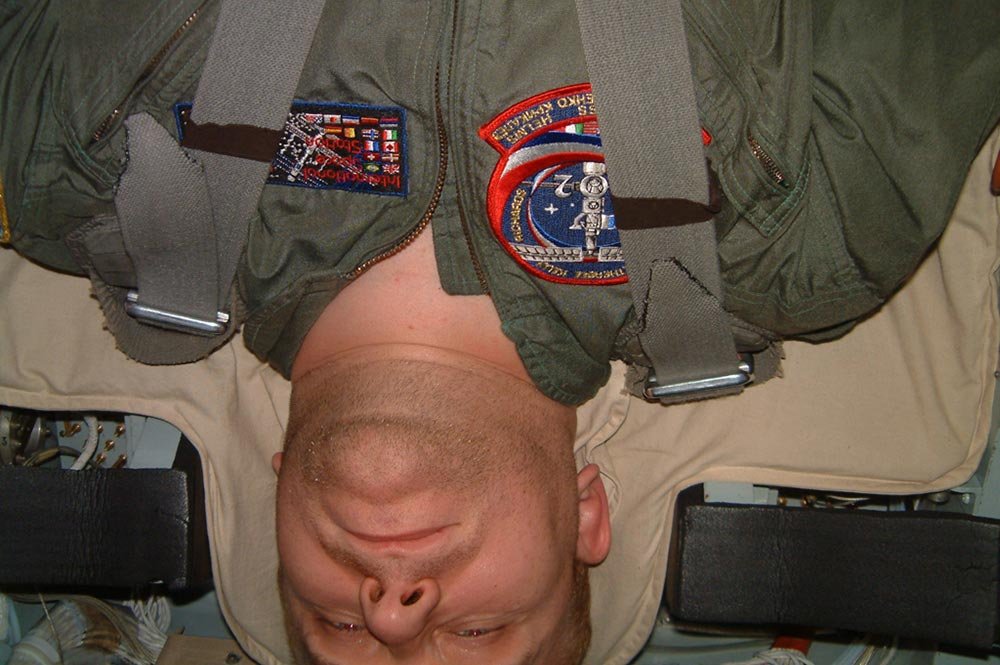 After the drive - TFS-18 - September 2003
After the drive - TFS-18 - September 2003The seat is rolled back, then I am freed and get up. Strangely enough, I don't waver and have complete control over myself and my sense of balance. Well, you can already tell that you have been under a lot of strain, and I also suspect that one day later I will definitely have sore muscles, but what makes a little sore muscle out! Nothing. Muscle soreness is uninteresting if you have been on such a journey, even if not for long.
The trip with the centrifuge took me another step further. Maybe these things will really bring me to the stars. I've definitely made it my goal, and the doctors and psychologists also confirm: "You have the Right Stuff!
To feel opposing forces in two days: one-day weightlessness, floating completely free in space, the next day pressed firmly into the seat with full acceleration force. A truly extraordinary experience. And the beauty is there: When I go to the fair, no one gets me on a roller coaster or in an extreme haves fun part. But, it's a head thing! Everything happens in your head. Surely you have to have confidence in the people who look after you. You have to have faith in the technique; otherwise, you can't prepare for a journey that will take you to higher spheres. Definitely not!
By Andreas P. Bergweiler – TfS-18 Soyuz Descent Training – 04/09/2003
Andreas P. Bergweiler

